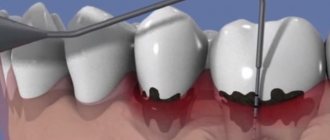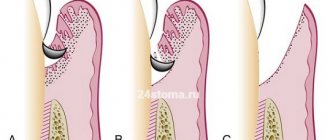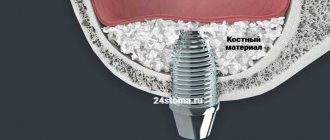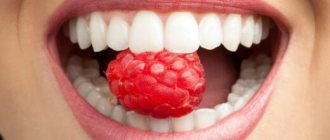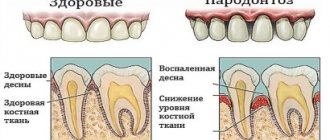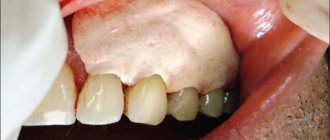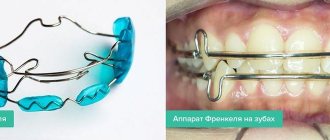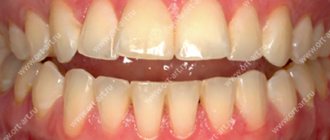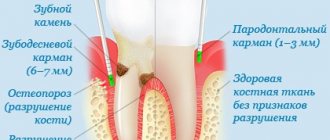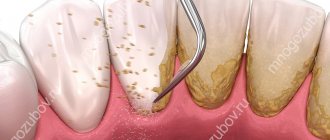Plaque and deposits are the main factors provoking the development of periodontitis and diseases of the supporting apparatus of the tooth. Without regular cleaning, they accumulate, forming a pocket between the gum and tooth - a source of infection and inflammation. Curettage (cleaning) of the periodontal pocket is a mandatory step in the treatment of periodontitis.
Periodontal diseases are the leading cause of tooth loss. 30% of all visits to dentistry are caused by problems with it.
- When to use:
for periodontitis - Type of anesthesia:
Local - Procedure time:
from 1 hour - Treatment period:
Depending on the degree of periodontitis (once a year) - Age restrictions:
from 18 years old (in our clinic)
Periodontitis develops asymptomatically at first and is difficult to detect at the initial stage. Therefore, preventive visits to the dentist 2 times a year play an important role. The doctor can notice the problem in time and take action without waiting for the teeth to begin to loosen and fall out.
Otherwise, the disease progresses, the teeth and jaws do not function to their full potential. Health problems appear, quality of life decreases, and psychological difficulties arise. Periodontitis is accompanied by destruction (death) of periodontal tissue and atrophy of the gum bone tissue.
How to do curettage
Curettage is a surgical operation.
Plaque, stone, and pathological tissue are removed from the periodontal pocket. If necessary, osteoplastic surgery is performed. This is necessary if bone resorption has already begun. Curettage must be carried out in the treatment of periodontitis and periodontal disease, as this is one of the most effective methods for eliminating inflammation in the gums. According to the technology of the procedure, there are two types of it:
- Open;
- Closed.
Closed curettage
Can be used if the depth of the periodontal pocket does not exceed 5 mm, and pathological changes in the bones have not yet begun. When performing closed curettage, pathological tissues are exposed to ultrasound and hand instruments in the form of hooks, with the help of which granules are removed from under the gums. There is no cutting of the gums, so the procedure can be considered more gentle.
Flaws:
- The doctor performs the operation almost blindly; he does not see the subgingival space. Therefore, it is not possible to thoroughly clean the periodontal pocket in all cases.
- There is a risk of incomplete cleaning. Success largely depends on the experience of the dentist performing the procedure.
Due to its characteristics, closed curettage is suitable for mild to moderate periodontitis and periodontal disease. Sometimes it becomes the only possible method, since others cannot be used for some reason.
Which treatment method is most effective?
To summarize, it must be said that each of the presented methods has both advantages and disadvantages. Therefore, at the initial stage of periodontitis, closed curettage will be the most effective treatment method. But it is worth remembering that the results of this treatment method are short-lived. Therefore, in the future it may be necessary to repeat this operation several times.
Moderate and severe forms of periodontitis require open curettage or flap surgery. These techniques can guarantee not only the elimination of the problem, but also the prevention of its progression in the future.
Regardless of the chosen treatment method, you need to remember that you should never neglect your dental health. If problems of various kinds arise, you should contact only specialized dental clinics.
Make an appointment with a therapist by phone+7(985)532-21-01
Laser gingivectomy in the area of one tooth
Open and closed curettage of periodontal pockets
Splinting teeth for periodontitis with fiberglass and tape
The roots of the teeth are exposed - what to do and how to treat them
Laser gingivotomy - surgical treatment of complex forms of periodontitis
Treatment of generalized moderate and severe periodontitis
Open curettage
Used if the depth of periodontal pockets is more than 5 mm. This is a surgical intervention, but compared to a closed one, the effectiveness is much higher. Since open curettage requires cutting into the gums, the operation is performed under anesthesia.
Stages:
- The doctor cuts the gum and peels it away from the tooth. After exfoliation, the tooth root is completely exposed. The dentist gets full access to the bone tissue.
- Cleaning and antiseptic treatment. The roots are cleaned of accumulated plaque and stone and polished using a burr and special pastes. After this, the tissues are treated with an antiseptic.
- Osteoplasty. This stage is not always necessary. With advanced periodontal disease, bone resorption gradually begins around the teeth, which will lead to loosening and tooth loss. In order to restore the bone, osteoplastic material is implanted.
- Suturing. After plaque removal, the gingival flap is returned to its place and sutured. A bandage with an antiseptic solution is applied on top.
Open curettage is a more complex procedure, but more effective than closed curettage. The surgeon sees the entire subgingival space and has access to bone tissue. Therefore, the quality is very high; both plaque and granulation tissue are completely removed from under the gums.
If necessary, open curettage can be performed simultaneously with flap surgery. It is indicated if the gum tissue is loose and the gum contour is disturbed. Very often, with periodontal disease, the gums begin to overhang the teeth. This violates the aesthetics of a smile. During flap surgery, the dentist removes excess mucous membrane and then sutures the gum.
Causes of periodontitis
In most cases, the onset of the disease is preceded by mechanical damage. It can be one-time (injury) or permanent (rubbing against an incorrectly installed prosthesis). As a result, pathogenic microorganisms penetrate into and under the gums.
Inflammation also provokes:
- plaque;
- tartar;
- low quality prosthetics;
- insufficient oral hygiene;
- increased load on the teeth as a result of the loss of some of them;
- malocclusion;
- smoking;
- age.
First, the upper layers of tissue become inflamed, and gingivitis begins. It does not always lead to periodontitis, but it always precedes it. Bleeding gums and bad breath are reasons to consult a doctor.
If gingivitis is not treated, it becomes chronic. The inflamed tissue becomes loose, and more and more bacteria penetrate into it. They get lodged under the gum, destroying the ligament around the tooth root. A space appears between the tooth and gum - a periodontal pocket. It accumulates minerals, waste products of bacteria, and the remains of dead tissue. Tartar forms. To get rid of it, dental curettage is performed as part of a comprehensive treatment of periodontal inflammation.
Rehabilitation
Curettage of periodontal pockets is a surgical operation, after which there will be a period of rehabilitation. Following the recommendations will speed up gum healing, make it less uncomfortable, and avoid complications.
Oral care rules depend on the method:
- Closed curettage. Immediately after surgery, you should not eat for several hours. On the first day, it is better to refrain from brushing your teeth with a brush and toothpaste, replacing it with rinsing. During the entire rehabilitation period, you need to monitor your diet - exclude solid foods and foods containing dyes. After curettage, there may be increased sensitivity of the teeth and gums. A special paste that your doctor will recommend will help you remove it. It is imperative to rinse your mouth with solutions of strengthening and anti-inflammatory medications.
- Open curettage. Since this surgery requires cutting into the gum, recovery takes longer. Recommendations for the first 1-2 days after surgery are the same as for closed curettage. It is very important to minimize the possible stress on the gums and teeth. It is advisable to reduce physical activity at first. Until the stitches heal, your mouth should be rinsed with solutions of antibacterial and anti-inflammatory agents. This will help speed up healing and tissue regeneration.
How to care for your oral cavity in the postoperative period
Experts note the huge role of postoperative care in the effectiveness of curettage cleaning. First of all, this is due to the fact that even a minimal amount of pathogenic microflora that gets into a surgical wound can cause inflammation and associated negative consequences. Therefore, after curettage, the patient should strictly adhere to the recommendations issued by the attending physician. You should not eat for 3 hours after surgery. For the first week, food should not be hot or cold. Dishes should be of a soft consistency so as not to injure the mucous membrane. Also, before the stitches are removed, it is not recommended to engage in sports and heavy physical labor, go to the bathhouse, to the beach, or to the solarium. In addition, it is necessary to take a course of antibiotics prescribed by a doctor and follow instructions for treating the gums with antiseptics (rinses or applications).
The network of dental clinics “Smile” offers services for the treatment of periodontitis, including the method of open curettage. Contacting our specialists has a number of significant advantages:
- treatment by highly qualified doctors;
- compliance with diagnostic and treatment protocols in accordance with international standards;
- providing family and cumulative discounts;
- transparent pricing;
- Convenient work schedule: daily until 21:00 (Sunday until 16:00).
You can make an appointment at any of the branches of our clinic in Moscow, located within walking distance from metro stations:
- Alekseevskaya (VDNKh district, etc. Mira), address: st. 3rd Mytishchiskaya house 3, building 2;
- Shelepikha, address: Shelepikhinskaya embankment, building 34, building 1.
Highly qualified specialists and modern equipment in all branches of our clinic allow us to perform periodontal treatment, including closed curettage, regardless of the severity of the disease. After preliminary diagnosis, our doctors will develop an optimal treatment plan for a specific clinical case and effectively implement it. Your health is in good hands!
Flaws
Gum curettage is a simple dental operation with good results. However, it is not without its drawbacks:
- Traumaticity. Like any surgical intervention, curettage injures soft tissue.
- The need for anesthesia. Normally, the operation is performed under local anesthesia. Sedation or general anesthesia is used in extreme cases or when the patient is in panic.
- Rehabilitation. The gums heal quickly, but at this time it is necessary to follow the recommendations and take care of the oral cavity. Infection of the wound can lead to complications.
Alternatives to curettage
Alternative technologies are suitable as prevention or in the early stages of pathology development. At the Zuub clinic they use:
- Comprehensive teeth cleaning. This is good prevention. It can be used as one of the stages of complex therapy, but not as an independent treatment. During cleaning, using ultrasound and a mixture of water, air and soda, tartar and plaque are removed from the surface of the teeth. You won't be able to empty your pockets this way.
- Treatment with the “Vector” device. A method for cleaning and disinfecting shallow periodontal pockets. In mild stages of periodontal disease, it can be used as an alternative to closed gum curettage, but it cannot replace open vector therapy. "Vector" is more effective than classic complex cleaning. It is based on a combination of exposure to an ultrasonic wave and a special suspension with abrasive particles. Since the ultrasonic wave is applied vertically, it penetrates deeply under the gum. In addition, ultrasound has a good disinfecting effect. Thanks to this, with a small depth of periodontal pockets and an undeveloped pathological process, it can give a good result.
The periodontist selects the gum treatment technology based on the clinical picture.
Come for a consultation with a dentist at the Zuub clinic.
Indications for surgery
The physiological depth of the periodontal pocket is 1.5-2.5 mm. With a depth of more than 3 mm, the pocket is considered pathological and requires intervention.
Other indications are:
- intensive deposition of tartar;
- plaque;
- inflammatory processes in the periodontium.
Tartar removal is an important, but not the only component of treatment. It includes:
- Anti-inflammatory therapy.
Its goal is to reduce swelling, pain, and bleeding of the gums. Periodontal pockets are washed with antiseptic solutions, and antimicrobial and anti-inflammatory drugs are prescribed. - Physiotherapy.
Light therapy, darsonval, electrophoresis, laser, gum massage are designed to activate blood circulation, tissue regeneration, and relieve pain. - Surgery.
Treating a gum pocket is just one of the surgical procedures. Infected tissue and abscesses are surgically removed. They replant tissues and cover exposed roots. - Orthopedic treatment.
Teeth are given stability by splinting, using dentures or light-curing sutures. For prosthetics, removable and fixed dentures are used, depending on the number and condition of the teeth.
